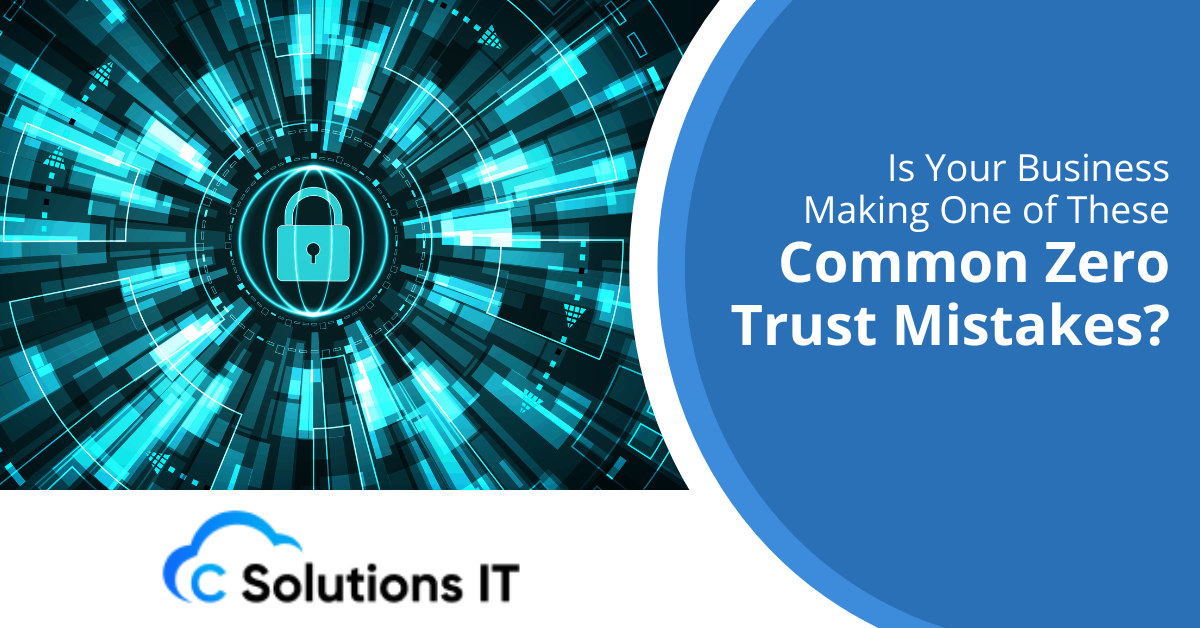Is Your Business Making One of These Common Zero Trust Mistakes?

Zero Trust security. You’ve likely heard this term a lot more in the last year than you have previously. There’s a reason for that. It’s the new superhero of cybersecurity promising unparalleled protection against data breaches and big improvements over the old “castle-and-moat” approach.
Nearly 90% of organizations globally have started embracing Zero Trust security.
Cast-and-moat describes the cybersecurity we’ve known since technology began taking over. You guard the castle by putting a “moat” (firewall and other protective barriers) between you and the outside world. Unfortunately, this approach has weaknesses because it doesn’t consider bad actors that have already breached the perimeter.
Zero Trust changes that mindset, which is why it’s becoming a standard in modern cybersecurity. But while Zero Trust offers incredible benefits, implementing it successfully requires a well-planned approach. Just like any journey, there can be pitfalls along the way. In this blog post, we explore some common mistakes to avoid on your path to Zero Trust implementation.
Remembering the Basics: What is Zero Trust Security?
Zero Trust throws out the old security model where everyone inside the network perimeter is trusted. Instead, it assumes everyone and everything is a potential threat – even users already inside the network. This may sound extreme, but it enforces a rigorous “verify first, access later” approach to data security.
Here are the key pillars of Zero Trust:
- Least Privilege: Users only get access to the specific resources they need to do their jobs, no more.
- Continuous Verification: Authentication doesn’t happen once; it’s an ongoing process. Users and devices are constantly re-evaluated for access rights.
- Micro-Segmentation: The network is divided into smaller segments, limiting the damage if a breach occurs.
Stumbling Out of the Gate: Common Zero Trust Implementation Mistakes
Zero Trust isn’t a magic arrow that you can simply fire and forget. Here are some missteps to avoid:
Treating Zero Trust as a Product, Not a Strategy
Some vendors might make Zero Trust sound like a product they can sell you. Don’t be fooled! Zero Trust is a security philosophy that requires a cultural shift within your organization.
Focus Only on Technical Controls
While technology plays a crucial role, Zero Trust success hinges on people and processes too. Train your employees on the new security culture and update access control policies.
Overcomplicating the Process
Don’t try to tackle everything at once. Start with a pilot program focusing on critical areas, then gradually expand your Zero Trust implementation.
Neglecting User Experience
Zero Trust shouldn’t create excessive hurdles for legitimate users. Find the right balance between security and a smooth user experience.
The Pitfalls of Poor Planning: Avoiding Security Gaps
Zero Trust implementation requires careful planning to avoid introducing new vulnerabilities:
Skipping the Inventory
You can’t secure what you don’t know exists. Catalog all your devices, users, and applications before implementing Zero Trust. This helps identify potential access risks.
Forgetting Legacy Systems
Don’t leave older systems unprotected during your Zero Trust transition. Integrate them into your security framework or consider secure migration plans.
Ignoring Third-Party Access
Third-party vendors can be a security weak point. Clearly define access controls and monitor their activity within your network.
The Power of Patience: Remember, Zero Trust is a Journey
Building a robust Zero Trust environment takes time and effort. Here’s how to stay on track:
- Set Realistic Goals: Don’t expect overnight success. Define achievable milestones and celebrate progress along the way. There’s no reason Zero Trust needs to be a burden if it’s done one step at a time.
- Embrace Continuous Monitoring: Security threats are constantly evolving. Continuously monitor your Zero Trust system and adjust your strategies as needed.
- Invest in Employee Training: Empower your employees to be active participants in your Zero Trust journey. Regular security awareness training is vital to keep your team’s cybersecurity hygiene solid.
Zero Trust Triumph Awaits: The Rewards of a Secure Future
By avoiding these common mistakes and adopting a strategic approach, your business can leverage the incredible advantages of Zero Trust security. Here’s what you can expect:
- Enhanced Data Protection: Zero Trust minimizes the damage from a potential breach by limiting access to sensitive data. This can save you considerable monetary damage in the event of a breach.
- Improved User Experience: Streamlined access controls create a smoother experience for authorized users.
- Increased Compliance: Zero Trust aligns with many industry regulations and compliance standards. Following Zero Trust protocols also reduces your risk in the eyes of cyber liability insurance companies.
We Can Help You Take the Steps for a More Secure Business Network
Zero Trust isn’t just a destination; it’s a continuous journey towards a more secure future. Our team of cybersecurity experts at C Solutions IT can help your Central Florida organization evaluate your cybersecurity needs and begin the journey to implement a Zero Trust approach.
It all starts with a comprehensive cybersecurity assessment. Contact us today to schedule yours.
